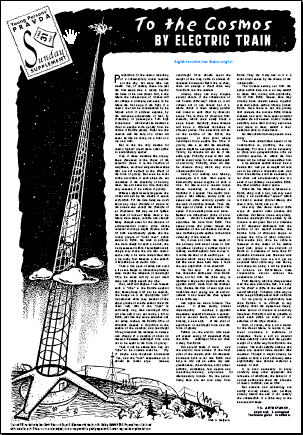When
| Title: How Close? | ||
|
[Cover Img] |
About:
|
Tags:
|
Abstract
This article answer a very frequently answered question - "when will the space elevator be built?". Prediction being what they are, we're not circling dates on a calendar - rather, we identify the major steps that have to be taken, estimate how long they will take, and track the current state of the art in relation to them. Spoiler: The short answer, btw, is that we think we can start building the first elevator by 2020, and have it operational by 2025. That's in 15 years.
Are we there yet?

Technically speaking, the Space Elevator requires two major achievements: a tether which is at least 30 GPa-cc/g strong (see below), and a long-range power beaming system in the Mega-Watt range. We define phase 0 as demonstrating these two technological building blocks, and we plan to do this by the year 2010, including a 10 GPa-cc/g CNT tether, and a multi-kWatt km-scale power beaming demonstration.
With these benchmarks demonstrated, we plan to pursue a 5-year development phase (phase 1) of full-performance components, followed by a 5-year system development effort (phase 2). This puts the beginning of construction (phase 3) around the year 2020.
The cost of phase 0 is well under 5 million dollars, and some of it is being achieved by the Elevator:2010 challenge project for significantly less than that. Based on current results and publications, we believe the objectives are very much achievable. (The results of phase 0, btw, are very much commercially viable, and we plan to use them to fund phase 1)
Phase 1 is the highest-risk portion of the development plan, since it aims to achieve the largest advance in performance. We estimate the cost of this researcg phase at under 200 million dollars, and it will result in removing any doubt about the feasibility of the SE project - by far the most important milestone in the plan.
Phase 2 is the main design phase - 5 years to design every nut and bolt on the anchor station, the climbers, the deployment systems... This is an aerospace design phase not much different than designing a new type of airplane or space capsule. The cost of this phase is much higher, and it will be performed by subcontracting to major aerospace companies.
Phase 3 is a direct continuation of phase 2, including the building of the ground infrastructure, the full length ribbon, the power beaming station...
All in all, we estimate the entire program to cost less the $10B - a small amount compared to the development and construction costs of programs like the Space Shuttle, the ISS, or even "regular" rockets.